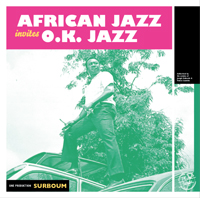 |
AFRICAN JAZZ INVITES OK JAZZ
UNE PRODUCTION SURBOUM (1961-1970) (Planet Ilunga PI11)
Surboum African Jazz was Joseph Kabasele's own label, and it was an important step in the history of African music, as it was the first label controlled by the musician whose music it published. Working for Esengo meant Kabasele's music was marketed in Congo but not in Europe; as he now had regular gigs in Paris and elsewhere he wanted to bring his music to the European audience also. In 1961 Kabasele (known as Le Grand Kallé) was in Brussels with his band African Jazz to record and invited Franco and OK Jazz, who were considered his rivals by the fans, to also cut some sides. This was a watershed moment in the development of the music. For once there was a relaxed atmosphere, the bands were not being driven to record in 24 hour marathons; on the other hand it was so relaxed they found they had a shortage of material and so revised and rewrote old material.
Members of the two groups, African Jazz and OK Jazz, had in fact merged a year earlier in 1960 when they went to Brussels for the Table Ronde conference. But in 1961 Dr Nico, the ace guitarist, temporarily split from the others and created his own wing of the group. So this group in the Fonior studio in Brussels were quite new incorporating members from Jazz Africain, who were in fact a kind of African Jazz tribute band, featuring guitarists Damoiseau and Casino to replace Nico and his brother Dechaud, and led by Edo Clary Lutula who sang alongside Kallé. But mixed in here are some recordings from a later session in which Nico and his brother returned to the fold: "Kajinga Victorine" is a Dechaud composition praising his girlfriend, with stinging lead by Nico. A Nico composition, "Ekoti ngai Hopitalo (They took me to the hospital)," tells of his loneliness when he was ill and alone. Kallé's "Mama Seba," from 1962, shows off his soaring voice against a chugging rumba dance rhythm with Latin style horns.
The commentary to each song is detailed and was created by musician Souzy Kaseya (ex-Vox Africa and African Team with Kallé) who wrote notes to each song; additional commentary was added by scholars Sylvain Konko and Samuel Malonga. Lyrics are transcribed and translated and all the discs are annotated in addition to having restored sound. So it is a monumental work, to say the least, continuing the tradition of excellence associated with Planet Ilunga.
OK Jazz kick off with a beautiful "Molinard danser cha cha" with a great sax solo (Essous?). Franco gives us one of his great poetic sorties, "Mibali bakomi mpasi na Leo," in which women complain about the shortage of men, with again a driving sax. These early 1961 recordings of OK Jazz show how tight and polished they were: full of verve, as the clipped percussion nicely balances the lyrical chording guitar and the languid touches from the saxophone adding another voice. "Ya mbala" sounded familiar and we learn it is adapted from Bakongo folklore. This was a strong source of ideas for Franco and even though the songs are less than 3-minutes long, we get a sense of the trancelike endless stretching potential of his rhythmically propulsive guitar.
Now, do you remember the early days of record players when you would stack discs like pancakes on a little player and after one played a lever would trigger the next to drop and you could have continuous play. That way if you played sides 1 and 3 then flipped both over you got sides 4 & 2. Here we have side one of OK Jazz then a sandwich of Kallé and African Jazz on 2 & 3 and back to OK Jazz for side 4, so that the two groups are intermixed. OK Jazz and African Jazz were still evolving, trying different styles, notably Latin American rhythms such as the cha cha cha. We also hear a merengue and a few boleros from OK Jazz. The first is a lament for the death of Lumumba, beloved nationalist leader who was murdered with the complicity of the CIA, and whose death precipitated the ongoing despoliation of the country. Side four is given over to Franco boleros (a favorite of label boss Bart Cat) with the mournful sax of Zimbabwean Isaac Musekiwa. The latter is given full rein on a novelty track, "A Girl I'm looking for," which is a truly ridiculous pastiche of Louis Armstrong's gravelly vocal style. It is so bad I threw it out, but on the vinyl you'll have to jump up to take it off before it ruins the mood.
The African Jazz material starts with a third recording of "Para Fifi": this delightful version features a tasty vamping piano from Manu Dibango who teamed up with Kallé in Brussels. Dibango also brings in Pepito's latin band for a straight cover of Beny Moré's "Pachito e ché" with vibraphone and horns over a cha cha rhythm, and a female singer. We then hear Dibango on piano (playing in a Cuban montuno style) chording on Nico's "Mi Jose," with the harmony of Kallé, Roger & Rochereau. This 1961 recording session stoked Nico's passion for Latin rhythms (Pepito also joined the band on tumba) and inspired him to try montuno piano vamping on the guitar. From 1962 we get the Jazz Africain guys delivering their Hindoubill cha cha on "Bueno Valentina cha cha" featuring Bombenga. (We learn this from Sylvain Konko, however the disc label only credits Kallé & African Jazz). The final African Jazz tracks come from late on, 1966, when sax player Jean-Serge Essous and sometimes Papa Noel had joined (1968), and then 1970 by when the group had become African Team with the addition of Cuban flautist and sax player Don Gonzalo.
What's amazing is that none of this material surfaced sooner (other than OK Jazz's "Motema ya Fa Fa," a classic heartsick blues, which Sonodisc reissued). An earlier issue on Planet Ilunga, Joseph Kabasele and the Creation of Surboum African Jazz (1960-1963), told the story of the label with a discography (African Jazz issued 212 songs; OK Jazz 136 on this label) and here we get more of the cream to lap up. |
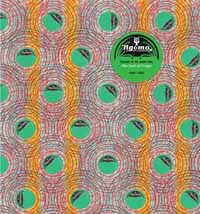 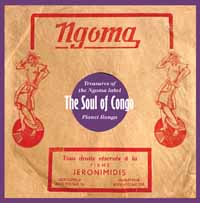
|
NGOMA: THE SOUL OF CONGO
(3 CD or 3 LP set from Planet Ilunga PI 10)
This is the press release, written by me. I also compiled and annotated the collection
Ngoma: the Soul of Congo is a compilation that spans the years from 1948 to 1963 as the Belgian Congo emerged from colonial subjugation into the first flower of Independence. Singers and players came to Congo's capital Léopoldville, from all over Central Africa — from the busy streets of Brazzaville on the opposite shore of the Congo river to the vast plateau of Mbanza Congo in Angola, from the mineral rich areas of Lubumbashi (Elizabethville) in the Deep South to the lively docks of Kisangani (Stanleyville) in the northeast, from the rocky wastes of Mbandaka (Coquilhatville) in the West to the majestic forests of Bukavu (Costermansville) in the East.
Léopoldville became a cauldron of musical syncretism between the African rhythms that arrived with these musicians and the European, Caribbean and Cuban tunes that were popular in the big city. The new sounds were recorded for one of the big five Congo labels: Opika, Loningisa, Esengo, Olympia or Ngoma. Musicians sang their songs in many languages: Lingala, Kiswahili, Kikongo, Tshiluba, Lari and Budja. And to show their urbanity: Espangol, a fractured form of Spanish, heard here in half a dozen selections. And although their lyrics covered many topics such as love, daily life, and the quest for freedom, their main message had no language since it was a musical one: to spread joy and hope.
None of the other Congolese labels better showcased the energy, variety & spirit of this era than the Ngoma label. During its existence, from 1948 until 1971, Ngoma made over 4500 recordings, creating a crucial cultural legacy, recognized as long ago as 1954 when poet Philippe Soupault wrote on behalf of UNESCO to Nikis Cavvadias, owner of Ngoma, thanking him for his work "collecting popular melodies and traditional songs which have caught the attention of the whole world. You've contributed to enlarging the knowledge of humanity."
As the Ngoma label flourished, so too did the first big stars of this new sound: Manuel d'Oliveira from San Salvador (who excelled in the polka piqué rhythm), Antoine Kolosoyi "Wendo'' from Bandundu and Léon Bukasa from Katanga. Cavvadias suggested they form a power trio, called Trio BOW and go on tour. He drove, and the tour lasted 20 months, reaching the borders of Angola and Cameroun. They crossed vast forests and rivers with help from locals who signaled their approach with tamtams or lokoles and then came out in the thousands to welcome the stars and fete them for their musical performances. The three of them are heavily featured in the Ngoma catalogue and in this compilation. They were all charismatic singers and guitarists who knew folk music but also adapted popular music from Cuba (heard on the famous GV records). Ngoma also provided a way for female singers, such as Martha Badibala, to rise to fame and inspire other women to dream of a life beyond taking care of the kids and husband.
Ngoma still recorded traditional folkloric music, such as the songs by old-time accordionist Camille Feruzi and likembe player Antoine Mundanda, but also looked for fresh talent as far away as Brussels where they recorded Camerounian heartthrob Charles Lembe fronting a fierce quartet on some flashy adapted Cuban Guaracha rhythms. Instrumentalists like Antoine Kasongo (clarinet), Albino Kalombo (sax) and Tino Baroza (guitar) also made their mark through the Ngoma recordings.
Adou Elenga's 1954 hit "Ata Ndele," that criticized the white colonists, led to his imprisonment and the song being quickly deleted from the catalogue (long sought after, a rare copy has been found for this collection). Already in 1953 he suggested a "change was gonna come," and slowly but surely it did. Angolan Paul Mwanga, too, was unstinting in his criticism of the colonials, and he was also active with authors' rights associations. Frank Lassan was a singer who brought the romantic style of French crooners to Congolese popular culture, while guitar wizard Manoka De Saïo or "Maitre Colon Gentil" (Genteel Settler) were flamboyant popular figures in the nightclub scene, captured on disc.
Guitar prodigies like Antoine Nedule "Papa Noel" or Mose Se Sengo "Fan Fan" cut their teeth as teenagers in studio bands (Maquina Loca and Jazz Babalou) which had fluid membership. The band names changed rapidly — Jazz Mango, Jazz Venus, Dynamic Jazz, Affeinta Jazz, Mysterieux Jazz, Rumbanella Bande, Beguen Band, Vedette Jazz, La Palma, Negrita Jazz — all of them are heard here. At first the word "jazz" was applied to the Cuban guïro or scraper, but as it came to indicate modern urbanity it was adapted for many band names.
As Nicolas "Dr Nico" Kasanda said, when interviewed by Michel Lonoh:
"Les anciennes réalisations de nos pionniers ont un place particulière chez moi. Ce sont surtout ces gens-là qui ont produit la vraie et la pure musique congolaise. Vous comprenez que nous sommes les produits de civilisations métissées. Pour nous garder Congolais, nous devons sur le plan musical, écouter, comprendre et pénétrer nos anciens pour ensuite les modifier et corriger quelques-unes de leurs erreurs qui résultaient de la primitivité. Personellement j'ai un respect absolu envers tous nos artistes de jadis."
["The early achievements of our pioneers have a special place for me. It is especially these people who produced the true and pure Congolese music. You understand that we are the products of mixed civilizations. To keep us Congolese, we must, on the musical level, listen, understand and penetrate our elders' work to then modify it and correct some of their errors which resulted from primitiveness. Personally I have an absolute respect towards all our artists of yesteryear."]
Now sadly, the Ngoma legacy has been decimated as many of the original recordings were played to bits or otherwise lost to posterity. A step towards preservation of our knowledge of Ngoma was made when Flemming Harrev created a massive discography and history of the label on his afrodisc website. When he died in 2020 the compiler had the idea of assembling a memorial disc in tribute to Flemming Harrev. He stated that afrodisc.com was "a tribute to the creativity and diversity of the performers," and now we have the opportunity of hearing some of the music, beautifully restored.
Dedicated record collectors came together to make this possible. From Morocco, the USA, France, Belgium, the Netherlands, Germany and Japan, these generous fans of the music have pooled their collections for this compilation, assembled and annotated by Alastair Johnston, author of the Discography of Docteur Nico, who runs the popular Muzikifan website from California. This is the first time such a massive sampling of Ngoma recordings has been gathered together. Legendary but unheard songs were tracked down, some emerging from dead stock in a forgotten Tanzanian record store. Experts who have made previous compilations were solicited for their advice and recommendations; liner notes, graduate theses, African periodicals, blogs and documents by authorities such as Jean-Pierre Nimy Nzonga, Gary Stewart, Manda Tchebwa, Sylvain Konko and Michel Lonoh were scoured for clues.
Ngoma: the Soul of Congo is the 10th release since the creation of the Planet Ilunga label in 2013 and their most ambitious project to date. Tracklist of the 3 LP set is here; tracklist of the #CD set is here
|
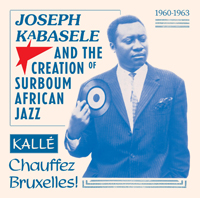
|
GRAND KALLE & AFRICAN JAZZ
JOSEPH KABASELE AND THE CREATION OF SURBOUM AFRICAN JAZZ (Planet Ilunga PI09)
This is not just a great double album of music, it's also an important historical and cultural document. For years we only knew the music of Joseph Kabasele, "le Grand Kalle," through the Sonodisc reissued LPs and CDs which infamously had no liner notes beyond the titles of songs. The Planet Ilunga label has been methodically recovering the first recordings of the music of Congo's early superstars, Franco and Nico, as well as Joseph Kabasele and the seminal groups African Jazz and Rock-a-Mambo. I have a baker's dozen CDs by Grand Kalle and his various groups, on Sono, apart from one on Syllart, and two on Gefraco. One on Sono, Grand Kallé and l'African Team, is even dated 1667-1970, showing their longevity! Eight tracks came from Surboum African Jazz, which is the label featured in this latest Planet Ilunga issue covering the period 1960-63. Then the first important collection came from Stern's in 2013 with Ken Braun's 2-CD set Le Grand Kallé: His life, his music which cherry picked the best of his career including a dozen tracks from the Surboum sessions, along with the crucial "Indépendance cha cha" and 'Table ronde."
This is a companion and sequel to the first Planet Ilunga album Souvenirs from the Congo, also 2013, which presented 26 tracks that spanned the entire career of Grand Kallé. As presented by Planet Ilunga the music and the documentation in this new collection are intertwined and dovetail to give you a rewarding understanding of the conditions under which the music was recorded and a snapshot of that moment in the career of these many hugely talented musicians. There are contemporary newspaper articles, many photos and even a discography of the African Jazz labels.
1960 was a crucial year for the Congo, for in the winter of that year a delegation of politicians negotiated the country's independence from Belgium in Brussels. As the discussions in the cold capital went on, the Congolese delegates had the idea of importing a band to brighten up their evenings ("Chauffez!"), and Kabasele was invited by a newspaper owner to put together a supergroup drawing from his own band and that of his rival Franco's. A superfluity of guitarists meant Armand Brazzos, who came from OK Jazz with singer Vicky Longomba, had to switch to double bass and learn it in three days, and a young 18-year-old percussionist named Petit Pierre was also drafted into their ranks. Once in Belgium they picked up a white jazz drummer Charlie Hénault. In Europe the band spent three months touring to increasingly ecstatic audiences. They had to turn down offers to tour as far away as Russia as fans rented buses to follow their gigs from Belgium to Paris and beyond. They had an afternoon gig at an upscale department store and evening gigs in clubs as well as the hotel where the politicians were staying. The entire story is told with many wonderful newspaper articles, featuring previously uncollected, marvelous photos of the band performing. Despite the existence of this archival material, including newsreel footage of the band, the story has been muddied by time. Now we get the complete timeline and an almost day-by-day account of the band's trips.
 Spread from Actualités Africaines, March 1960, courtesy Alan Brain
Spread from Actualités Africaines, March 1960, courtesy Alan Brain
The story is told by two experts: Alan Brain the film-maker whose documentary The Rumba Kings, which also recreates the Table Ronde concert, has just been released, and label-owner Bart Cattaert who fills out the story of the first African-owned and operated record label. After their return to Congo, and still ostensibly under contract to Esengo, Kabasele explained how he wanted to spread his music beyond Congo and with the backing of the newspaper and connections to Fonior studios, he returned to Belgium with a full band to record. The group included Roger Izeidi on maracas, the Baroza brothers on guitars, along with Damoiseau and Casino on guitars, Edo Lutula on vocals and clarinet: the last three from another group Jazz Africain. But where are Nico and Dechaud, you ask? They decided to stay with Esengo and released 18 singles under the name African Jazz aile Nico (the Nico wing). Back in Brussels Kalle added Camerounian sax player Manu Dibango to the formation. The two wings of the group were reconciled in 1961 when it was clear Nico was not a charismatic lead vocalist and the substitute guitarists in the mother-band were not that distinctive as soloists. Another trip to Brussels also revealed the emerging talents of the young singer Rochereau along with the restored band at full strength. Their great tunes, like "Africa mokili mobimba," "Kamulanga" and "Matata masila na Congo" were recorded on this visit. The band allegedly composed in the studio and played all day and night, sometimes passing out from fatigue or hunger. Manu Dibango in his autobiography complains about their "African sense of time" where a lot of messing about is followed by a one-take session. Maybe this is to excuse his sometimes feeble sax playing on these tracks; on the other hand his piano playing is very good, notably on the Latin numbers. As well as spontaneous composition, they drew from their broad repertoire and covered Dizzy Gillespie ("Wachiwara"), Don Alfonso ("Batucada") and even some South African tunes ("Mutatsi ya yombo"). Dibango returned to the Congo with the band (including Charlie Hénault) and with his own band African Soul, introduced the "Twist à Leo," one of five Dibango numbers included here, as they too recorded on the label showing it was a real commercial enterprise and not merely a vanity project. Along with the African Jazz tracks we know (from the previous Planet Ilunga album, Sono CDS36543, and 36582, as well as the Stern's set, Le Grand Kallé: His life his music) we now get 24 largely unknown numbers to give the bigger picture of what this group was all about. Interestingly it seems to be about experiment and diversification with some fine stretching out. Not all the tracks are "rumba Congolaise" by any means. There are many Cuban styles, charanga, cha cha, guaguanco, and on some of these Dibango plays piano but the horn part is taken over by a second-rate trumpeter. There are also ersatz Cuban numbers in nonsensical Spanish, such as Rochereau's "Oyeme querida" and "Pasie die senorita" and "Amor perdido" as well as "Luna nokera" by Mujos, presumably meant to be "No quiero la luna." On the praise song for Louis Armstrong "Satchmo okuka lokole" we hear Edo Lutula on clarinet. Outstanding is their cover of Enrique Jorrin's "Cuidado con la mano," covered as the nonsensical "Guidado colamano." On "Ambiance" Kalle shows off his crooner stylings in the manner of Corsican operatic tenor & film star Tino Rossi. It's a very French cabaret sound redeemed by Nico's guitar dancing around the melody. Nico also stars on his brother's composition "Bana ya nwa" a favorite of mine along with "Georgette ya ndeko," and, well, anything with Nico playing on it! We go back to South Africa for a jive version of "the Lion sleeps," by Dibango, with a more considered sax solo, and another twist called "Hallelouia," with Dibango to the fore. To me these Dibango tracks are extraneous, but, as I say, help to give the big picture of the label's scope. |

|
FRANCO & OK JAZZ
LA RUMBA DE MI VIDA (Planet Ilunga 8)
This well-conceived and sequenced album tells the story of OK Jazz's development during the 1960s. But it starts with the period 1970-72 and the Authenticité movement when Zaïre was reaching back into its history to fashion a new identity as distinct from a colonial one. At that point some of the elders of the music were brought back to public attention: we hear Camille Feruzi and his accordeon on the opening two cuts, as well as a composition by Ngoma label stalwart Manuel d'Oliveira. In addition to listening to the elders, Franco also changed his approach to the guitar, abandoning the plectrum for finger picking, using the plucked sound so closely identified with his playing, heard clearly here on "Mosala Etindi" where it is juxtaposed with punchy horns and "Casier Judiciare," a ballad about polygamy and divorce.
The second side takes us back to 1961 when Franco, unhappy with the sound of the new 45s from the Loningisa label in Leopoldville, turned to Joseph Kabasele who generously invited the band to Brussels to record there for his Surboum African Jazz label. The stripped-down band included Albino on trumpet and Isaac on sax, with Franco, Kwamy & Mujos on vocals. You have to wonder how Sonodisc missed masterpieces like "Ngai Muana na Weyi" when they covered this period. During their six weeks in the Belgian capital the band recorded 70 singles and Kabasele rewarded them with their own equipment: the first time they'd owned it themselves. The band were writing cha-chas and merengues but I am particularly fond of straight cover versions of Cuban and other Latin hits. The fans wanted it, and I am still crazy for it. "Revolver" is loosely based on "A Cataño" by Joe Quijano. It was also covered by Melcochita and Alfredo Valdes Jr on an album released in Ivory Coast by Lassissi. "Baila Charanga" is a cover of José Fajardo. Antonio Machin's "El Paso de Encarnacion," still in the repertoire of many salsa bands, is also given a work-out, with saxes to the fore while Franco just holds down a montuno riff that was the violin section on the original. I wonder if they understood the wildly provocative Spanish lyrics, "Change the steps and rip off your clothes"! OK Jazz really capture the rocking guiro and flute vibe of "El Piñazo" by Johnny Pacheco.
The fourth side, "Exhumation Folklorique" explores non-mainstream ideas in Congolese music including three songs by Franco is his native language Kikongo. He leaned on folklore for these fable-songs and of course, traditional rhythms are explored also. For a bit of polyglot fun Franco also sings in a made-up language in "Owana" a rumba from 1970 on his Editions Populaires label. This is a different approach to his catalogue and the fourth side showcases the strengths of the group with driving guitars, wonderful sax counterpoint and Franco's commanding vocals. It is a masterful compilation, all round, plus the sound has been beautifully restored. |
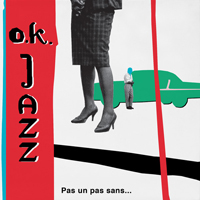
|
OK JAZZ
PAS UN PAS SANS... THE BOLEROS OF OK JAZZ 1957-77 (Planet Ilunga PI07)
For their third foray into the vast catalogue of the mighty OK Jazz, Planet Ilunga focuses on the bolero. The music is familiar and doesn't change much from track to track. The constants are Franco's scratchy vocals and his sparkly guitar. What you do notice over this 90 minutes of boleros is different horn men (Isaac, Pedro, Verckys) and the occasional different vocalist (Kwamy or Vicky) taking the microphone. What's remarkable is how new it all is, despite the immediate familiarity. Most of these tunes came out on small labels; the biggest chunk (10) from Pathé in Paris (who were bought by EMI, then Warner and re-emerged as Parlophone). Four singles were issued on Surboum African Jazz, Kalle's label, also pressed in Europe. Four come from CEFA, two from Franco's own label Editions Populaires, two early tracks from Loningisa, one from Boma Bango (which published OK Jazz and Negro Succès in the Congo) and one, the title track, was a promotional disc from Bata shoe stores. In terms of rarity, about a third have previously shown up on Sonodisc albums: the opening cut "Kenge okeyi..." was on a late Sonodisc comp called Slows classiques de la musique Congolaise; the first four tracks of side B, from the CEFA label, were also picked up by Sonodisc: track B1 "Nakopesa Yo Etumbu" was on Franco 1963-6 (Sonodisc CD36521), despite being from 1962; the next track "Ngai Oyo Lia Ngai" has appeared on a couple of Sonodisc LPs (360 144 & 360 168); that latter Merveilles du Passé album also captured "Da Da de tu Amor," an old favorite which also appeared on the African Party LP. Again outstanding sax but you'll have to guess as to who it is. "Yeba Nameki Komeka" popped up on Slows Classiques and elsewhere. Vicky Longomba sings this one, while Franco concentrates on a tasty guitar lead. If you are a fanatic OK Jazz collector like me you will also have Sono CD36555 Franco Kwamy Vicky 64-5. Of course these are all out of print now, as Sonodisc is dormant since the death of Jean Karakos in 2017, but it includes the riches of "Niongo na yo nakofuta" with Franco trying out "dry" guitar for the lead. "Mosika Okeyi Zonga Noki" also appeared on Slows classiques de la musique Congolaise, and on the Sono CD OK Jazz 66-7. The woman singer is not identified.
Side three is uncharted terrain: "Veronica" is a lovely ballad by Edo; then we get to the title cut, with the band extolling the virtues of the proletarian footwear (for those who can afford shoes): Bata. It's a love song with a delicious sax (Isaac?) and Franco pouring his heart out over some rubber flipflops. They are the only game in town, but still need to advertise, like Guinness beer in Ireland. The band put as much passion into this as their ads for Volkswagen or Mobutu's Authenticité campaign, rendering them all equally insincere.
"Si vous passez par là" is a drippy ballad that appeared on the Pathé Congo? Bolingo! comp. ("Bolingo" is Lingala for love, but also means "naked" in the polyglot vocabulary of my Luo friend Jerome, chief of the hoof eaters.) If you are keeping track, "Tembe Ezali Mabe" appeared on Tango ya ba Wendo-- I only know this because I am a compulsive Franco collector even though some of these comps just recompile other ones. What I learned to my chagrin is the CDs often abridge tracks; this is bad news if you dumped the LP and now the songs are all a minute or two shorter. "Ngai Tembe Eleka Ngai" the last track on side 3 is a different version from the one on Sonodisc CD36581, and came out as a Pathé single. "En Mémoire De Bavon" kicks off side 4. This wonderful ballad by Vicky previously came out on an incredibly scarce Pathé album, and before that as a 45 rpm single. I've never heard it before, and it's fantastic. Two much longer tracks by Franco follow and show how he took the bolero format and used it for his extended poetic discursions. The big climax is "Tolinganaki toboyanaki" which was on the "Monzo" LP from Sonodisc (360 104, aka 1977 vol 1) and came out as both sides of an Editions Populaires single, running to 9 minutes and 15 seconds. This is a good place to end but Bart goes back to 1965 to throw in a bossa nova, "Je t'attends (I will wait for you)," again sung by an unidentified woman, to wrap things up. So here's 80 plus minutes of mellow tunes by Franco and OK Jazz. If you are not obsessive then probably most of this is new to you and then the question is, do you want a double album of slow tunes by OK Jazz? The answer is almost certainly yes.
In my youth there was an urban myth that if you brought a date home, and put on side two of Marvin Gaye's mellow 1973 album Let's get it on, you would get lucky. It did work, intermittently. In those days you had a record player with a hook to keep the records balanced before they dropped onto the pancake stack below for continuous play, but if you left the arm up the side would repeat, and side two of "Let's get it on" allegedly did the trick. It was certainly the right soundtrack, if you did manage to score. One admires Planet Ilunga's determination in putting together this set of nothing but boleros. The only downside is the poor packaging: I think Bart lost his mind on the cover which looks like bad new wave design from the 1990s, but he will insist it's about the music, and since there's a niche market for this, most customers may not object as vehemently as I do to such awkwardness. There are many fine photos by Jean Depara in the booklet, any one of which could have made a splendid cover. And where are the gold and black diamond checks of Bata shoe stores?
Note: Early purchasers can also get a bonus 45 of another bolero "Botika kosomba ambi" which is backed with a ballad from Orchestre Negro Succès. |
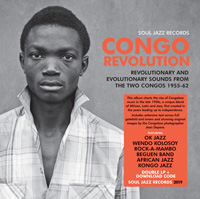
|
CONGO REVOLUTION
REVOLUTIONARY & EVOLUTIONARY SOUNDS FROM THE TWO CONGOS 1955-62 (SoulJazz)
There's a chicken and egg argument about early Congolese music. Scholars, with more or less credibility, claim that Cuban music evolved from various or specific African rhythms. In the 40s, with the global rumba craze, son Cubano gradually replaced indigenous maringa music. Wendo is always credited as first to use the 3-2 clavé rhythm, à la "Peanut Vendor," on his hit "Marie Louise," marking it as the first Cuban-derived rumba in Congo. But listen to the two recordings he made of "Marie Louise" (on Ngoma: the early Years): the 1948 is solo guitar and not remotely Cuban. A decade later he remade it with the Beguen band and the percussion adds a Cuban beat, which is in fact a cha cha cha. One problem for scholars is the shortage of extant examples of recorded music from the 1940s. Thanks to Yoshiki Fukasawa I was able to listen to a brass band, Odéon Kinois Léopoldville, playing "Josephine" from 1946 (Olympia 23): a percussionist plays a clavé beat with a metal bar throughout. Now we approach the truth but more work has to be done. Wendo was self-taught on the guitar; a far more accomplished guitarist with the confusing name of Jhimmy le Hawaiian (Zacharie Elenga), like Wendo a fan of Jimmie Rodgers the yodeling brakeman, was the first great Congolese guitar player and in my opinion he is the one responsible for the new music which came to be called "rumba Congolaise." (Paul Kamba, Léon Bukasa and Henri Bowane are other contenders.) With Jhimmy the guitar comes to the forefront as he plays solos to echo the vocals. There's a video of him with a young lad in shorts singing along, named Charles Mwamba Mongala, later famous as "Dechaud" (the hot one) after he learned guitar from Jhimmy. Jhimmy recorded at Opika in the early 50s, with Paul Mwanga and young Joseph Kabasele on vocals. Cuban-style "rumba" (i.e. son-prégon and son-montuno) evolved in the studios of Loningisa, Ngoma, Olympia, Opika and Esengo: the Greek-owned labels in Leopoldville. During the struggle for independence, roughly the period covered in this new double LP set, the established bands were African Jazz, OK Jazz, Beguen Band, and Rock-a-Mambo. Congo Revolution dovetails neatly with the recent Early Congo Music 1946-62 discs, compiled by Yoshiki Fukasawa, and it neatly sidesteps the circular discussion about who was the first Rumbero in Congo. Instead of discussing the individual songs specifically however, the compiler gives a social, economic and political history of the music to provide context (while touching on important topics like censorship and royalties). The social history is important to lay out because the two main camps of Congolese popular music of that era, OK Jazz and African Jazz, were very different people. Franco's group were more streetwise, not exactly hooligans, but identifying with the Indoubil, or "Hindu Bills", who were marginalized kids into the escapism of Bollywood and Western movies (Buffalo Bill Cody, Wild Bill Hickok), and who created their own patois, while the more sophisticated group at Esengo were "évolués"-- westernized, educated and politically savvy members of the African middle class, a buffer group created by the Belgians with one hand out but their foot still on the neck. The évolués were pan-Africanists and helped get Patrice Lumumba elected Prime Minister, though the world was not ready for this surprise outcome of free elections. Some members of the group, notably Dechaud and his brother Nico, tried to remain apolitical while OK Jazz and most others sooner or later embraced the dictator Mobutu (with a little coercion). So the social dynamics are certainly an important but hitherto largely neglected factor in the music.
I agree with the compiler that Rock-A-Mambo is one of the outstanding bands of the period: they had a fluid membership including Nico, Dechaud and Tino Baroza on guitar, later replaced by Papa Noel, plus Nino Malapet and Jean-Serge Essous on horns who later formed Les Bantous de la Capitale. As the compiler writes, "they were without doubt one of the most adventurous, creative and free-thinking ensembles to take the sound of Leopoldville across the continent." Their fusion of African and Latin rhythms set the stage for many subsequent outfits.
The 21 tracks here range from slightly familiar to obscure but all are lovingly restored. Armando Brazzos, contrabassist with OK Jazz who died as this disc was released, leads off with a pair of Cha cha chas: "Del Zombo" and "Sois sage amour" -- both appeared on the 2017 Planet Ilunga compilation of OK Jazz The Loningisa Years. "Baila" by Essous & Rock-a-Mambo was on Planet Ilunga's earlier Souvenirs from Esengo. These are good but safe (and to aficionados familiar) entries, but then we are plunged into the boiling pot with a steaming merengue in Kikongo called "Kumavula Tubakueto" by Edo & OK Jazz (I don't want to hex him, but Edo is now one of the last extant members of Bantous & OK Jazz). Like Paul Mwanga, Edo adopts a traditional rhythm here. Another track here "Tokeyi Kobina Calypso" is attributed to him on Sonodisc 360 144. I am guessing Vedette Jazz, a mainstay of the early Ngoma label, were among the Hindubils: their bassist was called Lasso! Also on Ngoma, Beguen Band gets us going with the catchy "Yo me moero" (and the inevitable rhyme: "Yo te quiero"). Their singer was Tchade, their guitarist was Delafrance (later of African Fiesta), saxophonist Maproko, also of Rock-a-Mambo and Vévé. Dewayon & Conga Jazz deliver "Nalingi na ngai kubala te," another storming track (also a rarity previously only heard on a Pathé comp, African Retro vol 6, where it is credited to Bidama & Rock-a-Mambo). "La belle Lucie Botayi" by Kongo Jazz (composed by guitarist Raymond Brainck) is another of the stand-outs: it comes from the same rare Columbia EP as "Luiza" by the Bantous. "Cherie Nini" by Nico Kasanda & Rock-a-Mambo appeared on a rare Colombia LP called Congo Highlife in 1961, but only last year was collected on Planet Ilunga's Dieu de la Guitare compilation. "Flowers of Luckness" (or "Luckyness" -- but not Loch Ness) by Rhodesian Isaac Musekiwa, sung in weird English by Kabasele, is called a "Swing anglais" on the Olympia disc -- I'd be tempted to call it skiffle. Musekiwa had started at Esengo but feeling outnumbered by the three fantastic saxmen already there, took his sound to OK Jazz over at Loningisa. I think that's Belgian Gilbert Warnant on the Solovox playing the keyboard part. "Les Voyous," a romping stomping merengue in Lingala by Nino Malapet, is another Rock-a-Mambo gem. Tino Baroza cranks up his guitar to create a buzzing distortion on this, and for contrast we also hear Nico's wobble on another shimmering merengue. Since the French word "Voyous" means "hooligans" I would really like an explanation here. Is it a throwdown to the rival camp at Loningisa? Nevertheless I am delighted to get a clean copy of this cut, which originally appeared as the first disc on Esengo. I've already mentioned Wendo's "Marie Louise" (the cha cha remake with Beguen band) which pops up. To reinforce the theme of social consciousness there are three political tracks salted in: "MNC Uhuru," "Ngonga Ebeti Independance," and "Vive Patrice Lumumba." Without being didactic this set gives us a delightful tour of the two Congos as they emerged from colonial servitude into the modern world. There are a lot of minor typos in the booklet, which is a shame, but crucially there are many, many fantastic photos, most taken by Revue Noire journalist Jean Depara (who followed Franco from 1954), presented large for full appreciation. |
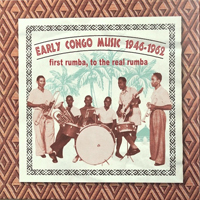
|
EARLY CONGO MUSIC 1946-62
FIRST RUMBA TO THE REAL RUMBA (El Sur Records)
Modern Congo was born in the 1930s with rapid urban expansion. According to Jeannot Diop, people from the countryside attempted to retain village practices in the new urban environment as a way of preserving continuity, so there was a degree of tribalism even as the cosmopolitan centers of Brazzaville and Leopoldville continued to grow. Music flourished on both sides of the Congo river as Western musical instruments such as guitars and accordions gradually supplanted traditional log (lokole) or frame (patenge) drums and likembes. The establishment of Radio Congolia in 1939, broadcasting local music, is a watershed. This is followed by the establishment of the Olympia record label in 1946. And that is where out story begins.
This two-CD set comes with an 86-page bilingual book, richly illustrated with labels and artist photos and includes notes on the lyrics of the songs. It's the complete opposite of that wretched and deceitful Nostalgique Kongo CD I reviewed a few months ago. Ironically there are two songs duplicated from that haphazard set: "Amis Benatar" by Jhimmy & Paul Mwanga and Wendo's "Bakosi liwa ya Wendo," both of them important to the history, but now we get some context to aid in our appreciation. Yoshiki Fukasawa is the compiler and author of this outstanding compilation. Apart from Flemming Harrev's discographies on afrodisc.com the only generally available information on the history of early recorded music in the Congo comes from liner notes, such as Planet Ilunga's albums or Sterns' few sets of Congo classics, and Gary Stewart's indispensable book Rumba on the River (Verso). As Fukasawa-san says in his introduction: "Reliable written information is crucial but listening to and feeling the actual music is most important of all to understand the popular music of the time." So he set out to collect the largely lost recordings of this era and this is where he made his first startling discovery. The earliest "rumba" records he found from Congo -- Orchestra Odéon-Kinois on the short-lived Olympia label in 1946 -- are a brass band! At the same time early guitar recordings by Wendo (widely traveled as one of the first "pop stars" of the Congo) were also labeled "rumba," so Fukasawa-san came to the brilliant conclusion that the term implied popular or cool music, and not a genre or rhythm at all. In fact it's not until African Jazz in the early 1950s, that anything resembling a clear Cuban "cover" is detected. (Rumba is also a problematic term because Congolese rumba is a blend of cha cha, son-pregon and son-montuno and is only obliquely related to Cuban rumba as heard in e.g. Los Papines or Muñequitos de Matanzas.) Highlife, brass band and palm wine music were earlier imports, coming with sailors and workers from Sierra Leone and Ghana. You can also spot elements of calypso and church music in the roots. Cuban music arrived with the gramophone in the 1930s and "rumba" was embraced for its familiar African rhythmic underpinnings. Real rumba, he tells us, is a result of Jhimmy the Hawaiian (Zacharie Elenga) and Paul Mwanga bringing a pop sensibility to the music to appeal to the youth, and adding what is essentially "animation" within the song. Sadly the two fell out, Jhimmy gave up music and from the core of musicians surrounding him at Opika, African Jazz was formed.
Previously there have been collections devoted to Loningisa (the two Roots of Rumba Rock sets on Crammed), Ngoma (two compilations on Popular African Music), and the two volumes on Ngoyarto Bankolo Miziki, which does not identify its sources, but is mostly from Ngoma, and seemingly all the tracks were rerecorded in 1973. Columbia & HMV reissued singles from Loningisa & Opika after 1957. Honest Jon's compilation The World is Shaking: Cubanismo from the Congo 1954-5 collects some of these HMV reissues. Fukasawa-san presents selections from all the labels, so he has the broadest range and the most insightful analysis.
The first El Sur disc shows the influence of palm wine and other styles on the development of the music. Traditional thumb piano still has a role in the rapidly modernizing country (just as it resurfaced with the electrifying "Congotronics" artists captured by Vincent Kenis a decade ago). Antoine Mundanda of Likembe Géant fame turns up with the unique whistle and likembe piece "Mabele ya Paulo." Of course there is a parallel with the finger-picking guitar style. This song about singer Paul Kamba's girlfriend celebrates the traditional within the modern urban context. Kamba was popular in both capitals across the river and the song combines conflicting even contradictory elements of the social experience, as commentators were keen to point out, this is the same sentiment that prefers imported beer to the local brew. This pseudo-sophistication also leads to rejecting domestic musical forms in favor of foreign ones. There's a nice 1946 solo piece from DeSaio who influenced DeWayon, Franco's teacher. As he finishes singing, leaving only his accompaniment, he calls out "Guitar!" I had to laugh. We hear Wendo, d'Olivera and Bukasa individually. They later formed the first supergroup in Congo: Trio BOW. Another big star in the '50s was Adou Elenga, son of a coastman guitarist from Ghana [correction: Flemming Harrev sent me an obituary of Elenga which states his father was from Zanzibar, but known as a great guitarist in his era]. Elenga's controversial political song "Ata ndele" was banned; he also had huge hits with "Tout le monde Samedi soir" (a cover of a popular Nigerian highlife song, "Everybody loves Saturday night" which according to Flemming Harrev probably has Caribbean roots) and "Maria Tebbo" which was reprised by Sam Mangwana (those tracks are on Ngoma: the early years, and the Bankolo Miziki albums; it's odd to have to revert to these liner notes from a Japanese scholar to get the necessary information about a compilation put out by Congolese and Belgians. On the other hand, the Ngoyarto set may be a bootleg reissue of Anthologie De La Musique Zaïroise Moderne issued by the state in 1974, so perhaps they were keeping their heads down).
We progress chronologically to the point where the real rumba starts breaking out, on tracks like "Baye-baye" by DeWayon with Wendo and a group that would become Watam a year later (with teenage Franco, whose mother rented a room from DeWayon where he kept his guitars). This is followed up with a powerhouse from Wendo: "Bakosi liwa ya Wendo," a "Peanut Vendor" cover with piano in the mix (according to the label: "3 guitares, piano, contrabasse & jazz" -- Jazz actually refers to a scraper!). "The Peanut Vendor" returns on disc 2 with a track from Gobi, sung by Lucie Yenga, backed by guitar, organ and sax. And while this influential Cuban number permeated all Africa, it is clear what we have been calling rumba roots is really a pan-African sound involving highlife, maringa and many indigenous folk influences. So Yoshiki's point is well-taken that "rumba" on the label does not refer to rumba in the grooves. We simply did not have a big enough sample of early Congolese records to judge accurately. Ngoma, which pressed 30,000 discs a month in their European plants, had no competition before Opika ("resist") came along but their master tapes were destroyed in a fire and their master collection in Kinshasa was destroyed in riots in 1989. As Wolfgang Bender says many discs by prominent names in their catalogues cannot be found. In short they were played to death.
If the first disc was the chrysalis, the second disc is the butterfly. On the second disc we note the personalities of Franco, Essous, Kabasele, Rochereau (with the magnificent "Catalina"), Tino Baroza and others emerging. Belgian sax player Fud Candrix brings real jazz to the studio and pushes the core members of African Jazz into exceptional jamming. And there are other discoveries here like Roger Salmson with Dynamic Jazz (Ngoma 1958), on "Ami amore bonita." There's a great clipped guitar solo by Dumana, and lyrical clarinet evocative of early OK Jazz. Roitelet and Le Beguen Band give us "Sala mbongo," a cha-cha, also from 1958 and also on Ngoma, that suggests Rock-a-Mambo. Of course the make-up of these groups was fluid. Core members from Rock-a-Mambo and OK Jazz, who had previously worked together in 1954 as Negro Jazz, reunited on Independence as the Republic of Congo broke from France. They moved back to Brazzaville to form the mighty Bantous de la Capitale, and the rest, as they say, is history.
This monumental achievement by Fukasawa-san not only combines scholarship with well-chosen music but is sequenced in a way to aid in our understanding. It constitutes a key document in the history of the development of Congolese popular music.
(NB: The compiler suggests, if you are outside Japan, buying from Farsidemusic or Ebay as the Tokyo publisher doesn't want to deal with international mail order.)
|
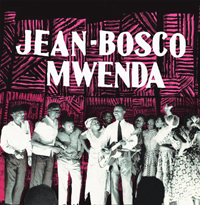
|
An historic encounter in African music took place on Saturday 2 February 1952. That afternoon, Hugh Tracey, on one of his safaris throughout Southern and Central Africa, looking for musicians, heard a busker playing in the town square in Jadotville (modern day Likasi) in south-eastern Belgian Congo. Bosco was 21 and had only been playing guitar for a year, but he was brilliant. He had perfect pitch and had developed a finger-picking style that resembled likembe/sanza or thumb-piano style, with both hands moving contrapuntally on the fretboard. The next morning, Tracey taped eight songs, including "Masanga." Tracey was so impressed with Bosco's picking he asked him for another take, without the vocals to hear clearly the exquisite arrangement. Later that year Tracey compiled a 10-inch LP that included two selections from Bosco, alongside George Sibanda, J.P. Odero from Uganda with "Kiss-cha-moto-moto" and other gems. The disc won an Osborn Award, the equivalent of an Oscar, and the African Music Society's album of the Best Music for 1952 kicked off with "Masanga" and "Mama na mwana." Tracey had a preternatural knack for discovering talent and his 1972 Gallo/Kaleidophone LPs Musical Instruments 6/7 Guitars 1/2 deserve a proper reissue. Bosco went on to record nearly 200 sides for Gallotone, the South African label, and made a few other recordings in Nairobi, even touring to Germany. His final recording session from 1988 appeared on Rounder. Mississippi Records has now put out a wonderful selection of 1950s recordings by Bosco, collected by sound engineer Michael Kieffer. These songs were hits in East and Central Africa and influenced an entire generation of African guitarists. (Listen to "Djamo Djamo" by Sam Mangwana's African All-Stars for a 1979 reprise by Dizzy Lengo, Lokassa ya Mbongo and Syran Mbenza.) Since Bosco was a master of many styles there is an interesting question of whether his records were influential further away in West Africa or whether he was picking up on what he heard. Someone taps on the table with a pencil while another plays a shaker as Bosco romps through "Masimango." He uses the percussionists to stagger the tempo on the guitar and it lurches along beautifully. Bosco was joined by his partner Losta Abelo on a few songs and someone striking a bottle in a quasi-clave pattern, suggesting they were familiar with the GV recordings of Trio Matamoros and others. Some of these tracks come from worn 78s implying the master tapes are no longer extant, though there is a Gallo archive in South Africa. The album opens and closes with two tracks that have appeared before: "Masanga" and "Mama kilio e" from the 1952 session. If you don't have it, that original session is included on The Very Best of Hugh Tracey (SharpWood 034). Bosco's gorgeous "Mama na mwana" can be found on Origins of Guitar Music (SharpWood 015) and the Cuban-tinged "Mwendo tulikwenda" is on Listen all Around (Dust to Digital 52).
|
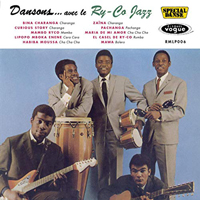
|
LE RY-CO JAZZ
DANSONS (Radio Martiko/Disques Vogue)
This collection of EP tracks and 45s from the legendary Ry-Co Jazz was reissued at the end of 2018 by Radio Martika in Belgium. Legendary of course implies that though they were big in their day their records became increasingly hard to find (& hear) as rich collectors bought them up, and today they are even scarcer. Ry-Co Jazz were a mainstay of the French Vogue label in the 60s. Formed by Henri Bowane at Loningisa studios in Leopoldville in 1958, their name was an abbreviation of "Rhythme-Congolaise." They went on tour to newly-formed Central African Republic and some members remained for 13 years! Exceptional guitarist Jerry Malekani joined them in Bangui in 1959. After a split from Bowane, four key members, singers Freddy Nkounkou & M'bilia Casino (also on congas), Jerry, and bassist Panda Gracia went to Nigeria and ended up in West Africa bringing the gospel of Congolese rhythms for four years, and recording in Dakar where they were heard by a producer from the French label Disques Vogue, who invited them to Paris. Cuban-influenced Mambos, a bolero and pachangas abound. You can hear the early OK Jazz and Rock-a-Mambo sound on tracks like the cha-cha "Maria de mi Amor" (from Vol 5, 1961). The bassist fell in love and stayed in Dakar; in Paris saxophonist Jean-Serge Essous joined up. He is heard on clarinet on "El Casel del Ry-Co," sung in Douala by Camerounian bassist Jean Dikoto Mandengue, from Vol 23, 1966. On tour their set list grew to include tunes like the Nigerian hit "Bottom Belly", and Dizzy Gillespie's "Wachi wara." Significantly they next went to the Antilles in 1967. Their seven year stint there, adding calypso and cadence (or "Kadans" in kriyo) to their repertoire, had a huge impact on the locals and some of their sidemen formed Kassav, the kings of zouk music. Their importance is outlined in Gary Stewart's book Rumba on the River, where he notes they returned to Paris to record and Essous went back to Les Bantous, to be replaced by Manu Dibango for a further North African tour. But their music evolved too and the Martiniquan style which permeated their sound in the 70s had a direct influence on the Paris recordings of Eddy Gustave -- check anything on the Eddy'Son label such as recordings by Pamelo Mounk'a, Théo Blaise, Master Mwana Congo or Sam Mangwana, for what is best described as the "Antillean lilt." This selection, of 10 tracks from the 100 or more they recorded for Disques Vogue, covers the early 60s before their Martinique trip. A sequel is promised, but this is their golden sound and, to my ears, much more coherent than the RetroAfric disc Bon Voyage which was the last anthology of their work, over a decade ago.
|
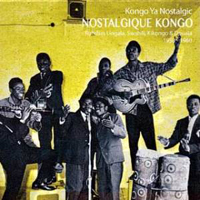
|
NOSTALGIQUE KONGO
KONGO ROOTS 1950-1960 (Buda Musique)
I was ready to be transported back to Congo in the 50s with this new collection from Buda Musique, idly thinking, hmm, it could turn into another hit series like their Ethiopiques which seems to have legs like Roadrunner. But, despite the superb music, there are some serious flaws in this compilation. First the writing is a pastiche of others' work on the topic, starting with this dumb remark: "The code name 'GV Series' had no particular meaning but local legend translated it into 'Great Vocalists'." Folklore is fine but the facts are there. A simple study of the label will reveal that GV stands for Gramophone and Victor: the parent companies.
The more I listen the more puzzled I am to tell what is going on here: is it some smart-ass kids who found a dozen 78s at a charity shop and decided they would make a great compilation? This seems the most likely explanation, as they don't really give much context for the songs, and to really ruin the mood the producers put cows mooing, ducks quacking and other barnyard noises on between songs that overlap the beginnings and endings of the songs (for continuity, anti-piracy, a lark?) ... What the hell are they playing at? There is no call for this kind of bullshit which verges on racism. The booklet is very shoddy, there are photos, ambitiously attributed to "the public domain" which show African Jazz (not represented musically), Nicolas Kasanda (also not heard here) and then some unidentified band shots, printed so dark you can't tell who it is. The cover photo is taken from a Novelty Jazz release, but Ngoma used the same photo for a Dynamic Jazz sleeve (Ngoma 72), making us wonder who the band really is. There is ONE picture of one of the discs: OPIKA 454 "Amis Benatar" by Jhimmy, sung by Paul Mwanga, and this is a great track (although, mysteriously, they refer to him as "Jimmy of the Hawaiian"). A quick search of the afrodisc.com catalog of Opika reveals two things: the full credit "Le guitariste hawaien Jhimmy et son ensemble; Chanteur Mwanga Paul" and the important fact it was recorded on 02-08-1951, and we also see the photo of the Opika sound truck that they lifted for the booklet... Next we find Ebenie Ebongue Bollanga, Olla Faustin et leur ensemble which was a Fiesta 78 (undated), but we learn from afrodisc they put out 9 singles in Cameroun. Flemming Harrev tells us it was an early 1950s operation and shows wonderful images of their paper sleeves.
Another Camerounian entry comes from Gustave Dalle, also on Fiesta. Would it be too much to ask these crack reporters to do some basic research on who these singers and guitarists were? Or simply write out all the label info for us?
Suddenly we go electric at the tenth track: Trio BOW with "Akeyi na Zanu." We do know they were on Ngoma and backed by the Beguen band. Beyond that it would be nice to get the lyrics translated or even transcribed, and please, leave off the cows... Occasionally they add rain sounds, perhaps to confuse you because they didn't remove the surface noise from the tracks. Three songs by Wendo are up next. He was the most popular of the Trio BOW, after his song "Marie Louise" became a pan-African hit. "Bakilo" -- actually it should be "Bokilo"-- was recorded 14-04-59, and he was backed by 3 guitars, clarinet, bass and jazz. A piano is added on the B side, also present. Camille Feruzi's Ngoma single "Bokamo ya babuti" is mislabelled as "Bokano ya babut" -- is it that hard to transcribe a label? Camille Mokoko's "Chérie Babolingo" is also mis-spelled. Adou Elenga is called "Elanga." "Bilengende" by Mokoko (It would have been useful to give his name, Victor, to distinguish him from Camille Mokoko) has surface noise which I could probably get rid of with free audio tools on my desktop. In short no one really made any effort to do a half-decent job on this release which is massively disappointing.
|
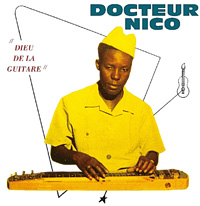
|
DOCTEUR NICO
DIEU DE LA GUITARE (Planet Ilunga 4)
Planet Ilunga previously published discs devoted to Le Grand Kalle, Rock-a-mambo and early Franco, so it is fitting they should turn to the next great name in that pantheon: Nicolas Kasanda, a.k.a. Docteur Nico, an artist who started out in Opika studios as a teenager and grew to be arguably the most innovative and original guitarist to come out of Congo. Nico's style is different from Franco's -- his nearest rival -- being more fluid, more ethereal, less rooted in the musical structure of the piece. While Franco was the Sorcerer of the guitar, Nico was considered the God. But rather than continue comparing apples and oranges, let us listen to Nico. I do not have the resources to pursue the rare early 78s, or even some of the Nico 45s that regularly come up on Ebay with asking price of $50 or more. I have lucked out and found one or two but my collection is mainly based on the 20 or so LPs released or distributed by Sonodisc and the ten reissued CDs which tended to muddy the waters with mislabelled or substandard additions (Between them they cover about a quarter of Nico's mature recordings as band-leader). I have tried to clarify the issue with two editions of my Discography of Dr Nico which lists most of the 134 singles on the VITA label from 1963 on and the subsequent 142 singles on Sukisa from 1966 to 1975. Ngoma, African, ASL & Decca/Congo also reissued these singles, though occasionally singles came out on other labels such as Philips or Super Contact.
This album surveys the complete history, particularly the obscure early work of Nico. After Opika closed in 1957 most of the artists moved to Esengo: Nico was just out of his teens but already the star guitarist on the label so he plugged into different combos for recording. Apparently one of his greatest recordings from this period is "Telegramme d'amour" -- this is a qualified statement as no one seems to have it, or at least be willing to share it. This reinforces the point that this cultural patrimony has been seriously mishandled by the French and Belgian labels who had the rights to publish and promote the music. They got it cheaply, in nefarious deals with the likes of Roger Izeidi and Rochereau, and (easy come, easy go) have discarded or mislaid tapes or master discs. Nico's own tapes were lost when his studio mysteriously burned down after he refused to record a praise song for the dictator Mobutu.
This overview starts from simple early studio work, with jagged guitar, upright bass, congas and claves, maracas, even a 1940s Solovox organ with its farty warmth. Among the miscellaneous rumbas we hear one outstanding folklore-based piece, "Tshiandanda Ngalula" which foreshadows some of Nico's later recordings (usually penned by his brother) that have the mutuashi beat of Kasai as their basis. Outstanding sidemen include clarinetist and sax player Jean-Serge Essous.
After his work at Esengo with African Jazz, Nico and his brother Dechaud broke away and formed African Jazz Aile Nico in 1961 but then returned to Kabasele briefly. By 1962 Nico was standing out prominently with tracks like "Kamulanga," reprised here, and the "shimmering" effect on "I'm sorry," another of his merengues. Roger Izeidi ran a hotel called the Blue Bar in Kinshasa and the German ambassador heard them and asked them to come and play in Germany. Kabasele did not make the trip, as he was going on his honeymoon, and he faxed them a request that they not use the African Jazz name, and this is when the group because African Fiesta. While a lot of Congolese bands used "Jazz" in their name, Fracasseur (the group's drummer) noted that Europeans who heard them knew they played rumba and thought it a bit absurd to call themselves jazz bands. Fracasseur was himself a good jazz drummer, having started out as conga player in a trio with Manu Dibango, then says (in conversation with film-maker Alan Brain) he was the first Congolese to play trap drums (but only in bars). Kalle's protég�é Rochereau was now the lead singer and the repertoire leaned heavily on the cha-chas and son-montunos of Orquesta Aragón, Enrique Jorrín, Sonora Matancera and so on.
Side Three focuses on the Vita years, 1963-6, when Nico, Roger Izeidi and Rochereau led the group together. From these 270 songs, Bart has selected a good cross section: a bolero "Moto abungaka" has lush guitar over a tropical guiro, conga and maraca beat. "Rose mosica" also shows the complex riffing of Nico in a Mujos song with Tabu Ley on harmony; "Merengue Matthieu," another rarity, has horn counterpoint to needlework-like guitar; "Vita Matata" is a classic Cuban cha cha (based on "Trompetas en chá chá chá" of Enrique Jorrín with new Lingala lyrics); "African Fiesta Congo" is one of the two songs on this side that have been compiled before. With "Omeli mayi na tonga" we start to hear the band emerging from the shadow of Cuba to create an original Congolese rumba, with great sax as a bonus. The lyrics curse Nico's enemies and say "He who seeks shall find, but risks falling on his ass..." The side ends with both sides of Vita 131, a disc I had no knowledge of until now. Side A is "Zola José" by Armando and side B a cover of Orquesta Aragón's "Recuerdos de Ipacaraí"-- misspelled as "Reguerdos" by the Africans. It starts so slowly you think it's going at the wrong speed, with a dull baritone sax bomp replacing the piano, and then the flute part transposed to trumpets. Instead of violins Nico wafts his lap steel swooshes over the proceedings. Later stars who passed through the ranks of African Fiesta include Sam Mangwana and Pamelo Mounka in 1965. But the egos of the three bandleaders were too big to contain them in one group. Roger & Tabu Ley left to form African Fiesta National while Nico went on to build his greatest group, African Fiesta Sukisa, adding André Lumingu "Zoro" on bass and Pierre "De la France" Bazeta on a third guitar to play between his lead and his brother Dechaud's rhythm: this new style was called the mi-solo. He added three new singers: Dominique Dionga "Apôtre", Valentin Sangana and Chantal Kazadi. Nico remade the band in his own image: the music evolved from covers of Cuban songs to original songs with great solos and Nico even bought a vintage 1957 Fender De-luxe "Hawaiian" lap-steel guitar with which he created a completely original sound. He also indulged in two new guitars: a "Dakota red" 1965 Fender Jazzmaster and a 1966 Hofner solid de-luxe with a white front and black back. Despite defections and having to rebuild the band more than once, Nico entered his most creative decade. African Fiesta Sukisa toured West Africa and came back with new dances, the kono (listen to "Sadi motema") and the kiri-kiri (e.g. "Baoulé," or "Lassan yembele ngai"), the latter an inverted version of the American dance craze "the jerk." In 1968 Bovic Bondo joined the band to bring a bit of the American funk and grunge sound. Personally I think it is gratuitous and really dislike his garage-band covers of Buddy Holly and Johnny Halliday. But Nico was giving the punters some variety and probably could leave the stage for a drink while Bovic did his shtick. One of his stand-by numbers was the merengue (he recorded half a dozen of them, and there's a "new" one on here) which, according to his manager, he could rip out while having a conversation with someone at the side of the stage.
"Souvenir Air Congo" was a promotion disc made for the airline. It's new to me, though the riff is familiar, but it is essentially a novelty. That leaves only space for four tracks by what I consider the peak of Nico's career: African Fiesta Sukisa, with Ngoualali Michel on flute and the wonderful vocals of Valentin "Sangana" Kutu and Chantal Kazadi, whom I believe are far more soulful than Tabu Ley and a much better fit with the music, especially the dreamy ballads with lap steel guitar. This band released 92 singles, then there was another fracture and a final great band with Josky and Lessa Lassan on vocals from 1970 to 75. Wisely Bart stops there and doesn't venture into the "comeback" recordings which are a pale echo of Nico's former glory. With help from Flemming Harrev and Stefan Werdekker, Bart has pulled some magical white rabbits out of the hat: great tracks unknown even to the discographer. The global reach of the internet has made possible a great network to pull Nico's legacy together.
|
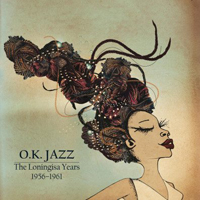
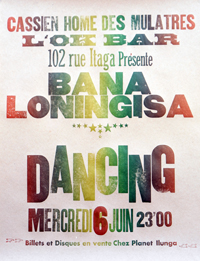
|
OK JAZZ
THE LONINGISA YEARS 1956-61 (Planet Ilunga 3)
On 1 September 1950 Henri Bowane cut the first disc for the Loningisa studios, opened by the Papadimitriou cousins, who were textile merchants in Leopoldville. Over a decade later, on 3 May 1962, the artist known as Geraldo waxed another rumba titled "Yo canto para ti" as the four hundred and first disc issued on 78 from Loningisa. In a handwritten note on their catalogue, deposited with the Belgian copyright society SABAM (& reproduced on the Worldservice blog) they state: "We have given up recording because of the political situation." Later, they stated that after President Mobutu declared the Republic of Zaire on 30 November 1973 they were forbidden, as foreigners, from continuing their commercial enterprises.
The Papadimitrious were one of four foreign enterprises (the others were Olympia, Ngoma and Opika) who specialized in producing Congolese rumba records for the local market. During those 12 years they nurtured some considerable talents and, as it turns out, half of their recordings were by members of a group that became known as OK Jazz, though they were essentially Bana Loningisa -- "the kids of Loningisa studio."
Bart Cattaeart has assembled 32 pristine tracks here, none of which are on the other key albums of this group's early days: Originalité (Retro2XCD 1999), with 20 tracks, or Roots of OK Jazz (Crammed Disc CRAW7 1993), with 19 tracks. But as Bart says, 90% of Congolese music from the 78 era has not made it to the digital age.
In volume one disc one of his 4-disc collection of the career of Franco, Francophonic, Ken Braun included 3 cuts by Bana Lonigisa (from Crammed's compilations) and three from Originalité, the famous "On entre OK, on sort KO (You come in fine, you leave knocked out)" and the blistering love song not about Demi Moore: "Tcha tcha tcha de mi Amor." But other early tracks have been hard to find. After De Wayon brought young Franco to the Papadimitrious to audition, the stable of musicians came together. Bassist Roitelet and singer Vicky came from the CEFA label, followed by guitarist De La Lune, singer Rossignol and clarinetist/saxophonist Jean-Serge Essous. Vicky had wanted to be an accountant but was soon busy as vocalist with both OK Jazz and Negro Succès. The band came together with a live gig at the OK Bar in the Mulattos Home, run by Gaston Cassien, himself a Belgian kid with a Congolese mother. Essous was chef d'orchestre and the musicians above were augmented by Pandi Saturnin and Dessoin on congas. Bowane took a huff over being left out and quit to work for a new label (run by another Greek businessman): Esengo (built on the remains of Opika), where he would gradually lure Rossignol, Roitelet, Pandi and Essous to form Rock-a-Mambo. Isaac Musekiwa was brought from African Jazz to fill the big hole left by Essous' departure, so there could be interplay between the horn and Franco's dazzling guitar. Trumpeter Willy Kuntima and another guitarist, Brazzos, joined in 1957. In 1959 there was another shake-up with half the band leaving to join half of Rock-a-Mambo in creating the Bantous de la Capitale in Brazzaville. Guitarist Brazzos and singer Vicky left to go the Table Ronde summit in Brussels with members of African Jazz; Franco was invited too but his wife Pauline forbid him to go. He struggled to continue but from then on OK Jazz was his band, and he increasingly put his personal stamp on it.
Like the music of African Jazz, Rock-a-Mambo and the Bantous, the early OK Jazz repertoire was deep into the Afro-Cuban boleros, rumbas, merengues, cha-chas and the occasional calypso. Franco even adapted Bakoko folklore, but by the late 60s he was forging the rumba-odemba sound with which he is most strongly identified. The 32 tracks here are in many ways similar to those other bands' repertoires, except in the "guitare parlante" and of course the vocalists. Cattaert has put together as wide an array as possible of styles, even including Colombian porro and Brasilian samba.
In contrast to Sonodisc who put out some early Franco material from unrestored records with no information other than title (often mis-spelled) and composer, Planet Ilunga has done an exceptional job of restoration, with the needed information. There is one slightly muddy track at the end "Bana OK Jazz": one assumes it was impossible to find a copy that had not been worn out on the Victrola. I had heard 8 or 9 of these tracks before from traders who had thrashed 78s, so the clean sound is a joy and a revelation. You won't find this exquisite music elsewhere, and it is a limited-edition pressing, so grab your copy a.s.a.p.
Note: I printed up an imaginary poster for the first OK Jazz gig at Cassien's Home of Mulattos in Léopoldville, 6 June 1956 [left]. Planet Ilunga gave these away with the first 80 orders; I have a few left, which are available from my Etsy page.
|
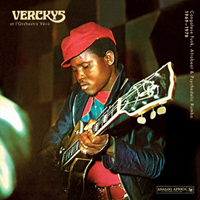
|
VERCKYS et l'Orchestre Vévé
Congolese Funk, Afrobeat & Psychedelic Rumba 1969-1978 (Analog Africa AA17 2014)
When you pull out all the stops on a church organ you get an almighty noise guaranteed to raise the roof. When Samy of Analog Africa does it, you get a killer album of rare tracks from one of the most rumbustious acts to come out of the Congo in the rip-roaring 70s. Georges Kiamuangana "Verckys" was a saxophonist with OK Jazz from 1963 but didn't always see eye-to-eye with his boss and finally, in 1969, broke away to create his own band, his own studio, and even his own label (in 1970) from where he threw hit after hit onto turntables across Africa, from Lagos to Nairobi. Though the sax was his main instrument (his nickname came from mishearing King "Kurtis" as "Verckys") he was soon to jettison the horns and feature the stripped-down acts of the generation Langa Langa which replaced the older dance bands of Franco and Rochereau. Verckys had monster smashes with his own band, Orch Vévé, as well as the numerous bands he nurtured like Orchestres Bella Bella, Kiam, Les Kamale, Empire Bakuba, Lipua Lipua, Les Grands Maquisards, Zaiko Langa Langa and Stukas. His first three albums were put out by Ngoma before he started his own state-of-the-art studio, to which he added a record-pressing plant. He then signed Rochereau and recorded four very successful albums, including Maze. In 1977-8 Sonafric issued a nine volume series of Grands Succès, Direction Verckys. Because of the great passion for Congolese rumba and cavacha in East Africa, Verckys went on tour to Uganda and Kenya. He struck a deal to reissue albums in Nairobi and recorded the smoking "Nitarudia" with Orch Vévé Star (So far, I've found a dozen albums released in Nairobi in those golden years 1983-5.) The audiences went wild. Any talented bass player was compared to Vévé's Shaba Kahamba. Some Vévé musicians decided to stay behind and formed Orchestre Bana Ngenge. The Vévé sound was so pervasive (and portable) that many Congolese acts moved East and played the stripped-down music with sax and multiple lead guitars. Other aspects of Verckys' career and his productions appeared periodically on Sonodisc in Paris. In the 1990s Sonodisc issued a couple of greatest hits CDs and RetroAfrica leaned heavily on them for its reissue called Vintage Verckys. Since I maintain the collaborative Vévé discography (elsewhere on this site) I can quickly pinpoint the source of these tunes, and it is really startling. Samy has had a fresh look, and only taken tracks from a couple of known albums: the rest are 45s and quite a few of them - six - obscure B-sides. Needless to say he has come up with the goods: every track on here is a revelation. Yes, I think the entire output of Verckys should be reissued & this first step in that direction makes a good case for that.
The CD kicks off with a sax-led funk track (with pidgin English lyrics), "Bassala hot," which was featured on Grands Succès vol 2 and reflects particularly the Nigerian passion for James Brown. But then we kick into the cavacha sound that became the high watermark in East Africa, with wild dueling guitars, snapping snare drums and sweet vocals harmonies. I am guessing Roxy Tshimpika is on lead guitar, but there was no info on individual tracks in my digital copy. I would love to know who is singing on here, and even the sax which I think is Moro Beya Maduma. I heard a shout-out to Aladji who is the rhythm, or mi-solo guitarist with the alluring name Aladji Baba. "Cheka sana" returns to the funk, this time with twin saxes (Matalanza or Verckys himself with Moro Beya?). "Oui Verckys" follows: this time organ-led and highly reminiscent of "Mother Popcorn" by James Brown. Enough with the funk, back to the mellow rumba with "Nakobala yo Denise," a love-song with lyrical sax and a kick-around seben at the midpoint of the 4-minute nugget. Organ returns with jazzy sax and a more psychedelic groove for "Sex Vévé," which brings to mind "Sex Madjesi" and Sosoliso, the splinter group from Verckys headed by his original trio of singers. This shows off his jazz sax while the guitars churn out blues chords. Back to the cavacha sound next (not sure this sequencing works, it jumps about a lot) for the lovely "Sisa Motema," then back to Famous Flames for the B-side of "Cheka sana," called "Talali Talala," another funk instrumental. According to Ben Redjeb three of the tracks were recorded in Nairobi. I don't know them and don't see any sign of them on kentanzavinyl either, so the originals must be pretty obscure. We strike a happy medium with "Zonga vonvon," which I would classify as a "rave-up," a speedy romp with shrill vocals and shouted chorus as well as some honking from the leader. The lovely high tenor voice on echo, launched by Tabu Ley and carried on by Nyboma was also a big thing in East Africa, with artists like Lovy Longomba and Nguashi Ntimbo. Here we get a taste of it on "Nakomi Paralise" (which may or may not be a typo for "Paradise"); singers unidentified. Actually my unease at the arrangement may be that we start with two long ten-minute tracks then have a real smorgasbord of seven varied styles until we get back into a groove with the 6 minutes and 41 seconds of extended bliss that is this guitar- and horn-driven workout. The shortest track is a charanga-style blowout called "Matinda comono" in pidgin Spanish. Then there are three bonus tracks (which I guess are not on the vinyl): "Nitarudia" is outstanding with sax and piano (a rarity) and a tight arrangement. I wish we had personnel listings on these cuts. Still it is a monumental set and bodes well for future reissues, from Analog Africa, with their faultless track record, and also for more from Mr Dynamite: Verckys.
|
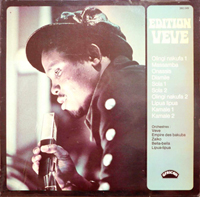 | EDITION VEVE (Sono African 360 049 - digital release via Stern's)
In one concise disc, this album tells the story of the successful beginnings of the Vévé label. The boss himself -- Verckys -- kicks it off with a two-sided epic about death, "Olingi nakufa." Bella Bella are up next, with Pepe Kalle singing on "Lipua Lipua," a song that gave birth to a new splinter group with the young Nyboma (Pepe Kalle didn't go along, but started his own band) when the Soki brothers decide to quit the label. Someone yells out "Chicken!" -- my favorite shout-out in this set. "Onassis," presumably a reference to the wealthy Greek shipping magnate, was an early hit for Zaiko from 1973. Zaiko signaled a new direction in Congolese music, getting away from the big band sound of OK Jazz with fewer guitars and no horns. It was a bold move, especially for the renowned saxophonist Verckys. Another over-miked scorcher is up next, "Diamile" also by orchestre Vévé: two minutes of a choral intro then the twin saxes kick it up for a concise blast off from the mothership. Side two (of the original LP) is another two-parter and one of the label's biggest hits, "Sola," a 9-minute monster by Bella Bella (written by Mulembu Tshibau, who also moved from this band to Lipua Lipua then to Les Kamale with Nyboma) that features a fanfare of horns at the start. The horns balance the vocals all the way to the bridge when we get a snappy snare and a mi-solo guitar (Kinzunga Ricos?) twisting and turning: the very quintessence of the sound that swept all of Africa in the mid-70s. The bass is high in the mix again for "Massamba" sung by Dilu Dilumona and Empire des Bakuba, who quickly assembled out of the break-up of Bella Bella and stuck together until the death of Pepe Kalle in 1998. Having heard Bella Bella's "Lipua Lipua" on side one, we now hear Lipua Lipua's "Kamale" another hit song, written and sung by Nyboma, that once again gave birth to a new band.
|
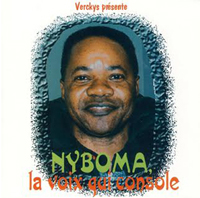 | VERCKYS PRESENTE NYBOMA
LA VOIX QUI CONSOLE (EVVI 145 - digital release via Stern's)
This Lipua-Lipua release has a preface which doesn't tell you about the band and their career or ask you to cast your mind back to the golden age of Congolese rumba, surprisingly, is a legal statement of the producer's rights to the music. In it, Kiamuangana Mateta (a.k.a. Georges "Verckys") says that he has noticed the publications of Glenn and Ngoyarto, in contravention of the various statutes covering Intellectual Property. One wonders what took him so long ("Verckys" was ill for a while), but now he is working with Stern's to put his considerable achievements as a producer back on the market. And we, the mélomanes or fans, have been waiting a long time for this, if only to sophisticate our thrashed copies of much-worn albums and cassettes. I suspect the master tapes were lost somewhere in Kinshasa during some civil unrest or military coup, or borrowed and never returned, so these reissues sound like they were taken from earlier CD reissues. But to true fans like myself this early work of Nyboma and Vata Mombasa is a piece of the Dead Sea Scrolls. The opening cut "Mombasa" is about the lead guitarist (rather than the seaport), and was included on a Sonodisc compilation in 1974 (as well as a Glenn bootleg in 1998). "Lemba-Lemba," "Matoba," "Mbonda" have not been collected on CD elsewhere and that is a treat (The latter were included on a very hard-to-find Sono LP L'Afrique danse avec Sakumuna Vévé 360 091 from 1975). "Amba" is on four other CDs that I have; this track and "Nouvelle Génération" were both on a King Jimmy release called Greatest Hits volume 2, but I suspect few people got hold of that one. The last cut "Masele" was also included on a Sonodisc CD Lipwa Lipwa de Nyboma, but I figured they had gathered all the extant tracks since they reused the same ones over and over. The group issued two dozen singles on the Vévé label, most of which were reissued on the Sono African label in Paris. But there is often a randomness to what gets collected. The best singles may not get anthologized because they were so well-loved no one can find a clean copy (though rumor has it the latest owners of the Sono catalogue are digitizing what they have). So it is a bonus to have three obscure but wonderful songs brought back to us in this compilation. Also, this is the order they were compiled in originally. It is always gratifying to hear a properly sequenced set from one band. The longest track on here, "Mbondo," clocks in at 12 and a half minutes. I can't stop playing it. The complex, creative and lengthy break-down on rhythm guitar by Vata Mombasa is outrageous. He does another tour-de-force solo in the next song "Nouvelle Génération," then in dialogue with the second guitarist Mongo Ley, accompanied by the bassist and the snare. To sweeten the deal even more, Stern's have also licensed a few stray singles, including two more by Lipua Lipua not included here: "Tika kosaboter motema" b/w "Kuelo" (from 1978) and "Nala 1 & 2" from 1975, and the elusive Orch Kiam's "Memi" (Sakumuna 15). For the record, Nyboma and co (Mulembu Tshibau and guitarist Kinzunga Ricos) felt they were being exploited by Verckys so left in 1972 to form Les Kamale, while Lipua-Lipua was reformed around Nzaya Nzayadio, Mbudi Malanda and guitarist Mongo Ley by the label boss. Nevertheless Kamale also recorded on the Vévé label. I guess he was the only game in town and while he assumed the rights, he did have the distribution, and paid them to record.
|
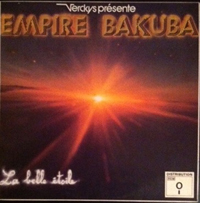 | VERCKYS PRESENTE EMPIRE BAKUBA
LA BELLE ETOILE (EVVI REM 360 - digital release via Stern's)
I didn't get this from Sterns' because, perversely, I like the (slight) snap crackle and pop on the copy I have taken from vinyl. Two of my favorite voices, Papy Tex and Pepe Kallé, harmonize beautifully on these four songs. The big man, Pepe Kallé, is credited with all compositions, though Tex sings lead on the title track and Dilu Dilu Mona is also singing harmony. There is sparkling guitar from Boeing 707 and Doris, fierce drumming from Samy Maracas and the rock solid bass of M.P. Cherie. It's a familiar set-up: an exposition of sweet singing for a minute or two, then the seben or turn-around where everything kicks up a gear and we go into a frenzied 7 or 8 minute workout. There's an added airhorn on these which is really unnecessary (actually it becomes irritating), given the explosive nature of the band in full flight. Maybe a kid with a vuvuzela snuck into the studio to join in. They sound like live recordings, as if they rehearsed then did it all in one take, singing and playing live without multi-tracking, which is probably the case, and adds to the immediacy. I believe this was released circa 1984. I can hear a Flanger on the guitar (which was first introduced by Boss in 1977, but Roland had effects pedals from the mid-seventies). There's a shout-out to "Pecos," a good Indu-Bill name for an animateur.
|
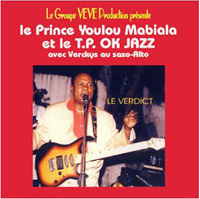 | YOULOU MABIALA & OK JAZZ
LE VERDICT (EVVI 999 - digital release via Stern's)
This is an interesting entry in the Verckys catalogue. Verckys the sax player had quit OK Jazz in the late sixties. In 1970 singer Youlou Mabiala quit OK Jazz and sang with Lovy du Zaire, but when lead guitarist Mose Se Fan Fan also departed OK Jazz, they formed Somo Somo (the great Syran Mbenza also played guitar in those two breakaway bands). It was a low point for Franco and it took him years to recover (his brother died to compound the pain). Though Youlou returned and scored a massive hit for OK Jazz with "Kamikaze" in 1975, it was just a temporary move (Sam Mangwana also had a revolving door to the band's front line when he needed it). In 1977 Youlou used the popular song title to create Kamikaze Loningisa. After Franco's death in the late '80s the band struggled: various attempts were made to revive it with Simaro (main songwriter), and singers Josky and Madilu System fronting the remaining players. Though the band functioned fine without his input, Franco had never been more important than in his absence. In 1994 Bana OK rose from the ashes, but until now I did not know there was a 2000 recording. The good news is it sounds like classic OK Jazz (no syndrums, lots of singers and horns creating harmonies). It's a nice long session, no personnel are listed though Verckys himself is leading the sax players. It was originally released by Andrew Crawford in Kenya, so may have been recorded there.
|
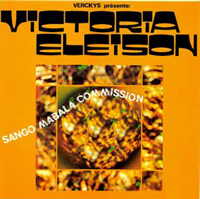 | VERCKYS PRESENTE VICTORIA ELEISON
SANGO MABALA COMMISSION (EVVI39/REM370 - digital release via Stern's)
Now that Stern's is involved in these reissues there is every hope they will be around long enough for fans to delve into them and expand their collection of great Congolo-Zairois music. If you look through my African reviews you will see many rare albums that appeared for a while, either on CD or digitally, and then went out of print. Many of the Verckys albums didn't make it further beyond Paris than Brussels. This branch of the Zaiko family with Jo Kester Emeneya, Bongo Wende and Joly Mubiala recorded in the mid-80s. The ten members had deserted Viva la Musica in 1982 after feeling they were getting short shrift from Papa Wemba. They were the mainstays of the Verckys label along with Langa Langa Stars, which was the branch led by Bozi Boziana, Dindo Yogo & Evoloko Jocker. It's pre-programmation so there is no drum machine and no synthesizers to mar the vibes: just great guitar-driven soukous to fill the dancefloor. The guitars were ably handled by old pals Huit Kilos, Safro Manzangi and Mongo Ley who had worked their way through many bands, including African Fiesta and Lipua Lipua. The leader, college-educated Emeneya had as much style and presence as Wemba but with his long hair and beard and the name of his new band sounding vaguely hymn-like he appeared more like Jesus to his followers, according to Gary Stewart, who also tells us Verckys loaned the band instruments in return for a four-year contract. Victoria Eleison was one of the most solid of the Clan Langa bands, others came and went, but eventually Rochereau's Afrisa lured away Huit Kilos the guitarist. Still, under Emeneya they went from strength to strength. In 1986 Emenya's "Kimpiatu" was voted song of the year, eclipsing Franco and his "Mario." A lot of this mid-80s soukous still stands up and you can sample much of it through Stern's reissues.
|
 | EDITION VEVE 1969-78Lately I have been binging on my favorite music. Of the four "new" Edition Vévé compilations assembled by Sterns to celebrate Verckys, I chose number 3 as the volume containing the most songs I did not have. The first of the series appeared as Bankoko Baboyi from Sono in 1998 and that is a fabulous collection of Orchestre Vévé material. Similarly volume 2 features the label boss in charge of his own band and includes blockbusters like "Ah! ngai Matinda," "Bilobela," "Baluti," Vivita," and "Nakomitunaka," some of which were also on the Sono release 36599 (originally three of them were collected on Grands Succès des Eds Vévé volume 3.) It is essential listening. I concur with Gary Stewart that the ballad "Nakomitunaka," which asks why God is white, is Verckys' masterpiece. Volume three kicks off with two songs by Gilbert Youlou Mabiala from 1968 or 9 before he rose to legendary status fronting OK Jazz. There is a rare cut from Makina Loca (the original band, not the modern band with the same name fronted by Ricardo Lemvo). Equally obscure and brilliant Orchestre Kiam give us "Baya Baya part 2." You can get the whole single as a separate download, which you will want once you hear this (It was on a Sonodisc release 360 062). Two cuts from Bella Bella may seem more familiar, "Mbuta" and "Sofele," as they appeared on a Sono compilation of les freres Soki, CD36602. This is from the earliest incarnation of the band with Pepe Kallé & Nyboma singing and the great Shaba Kahamba on bass. Fataki, Bitchou, Ricos, and Bissikita all get shout-outs on "Mbuta"-- what a line-up! The three Empire Bakuba tracks were collected on an Ngoyarto CD La Naissance de l'orchestre Empire Bakuba (NG085), each features one of the singers: Pepe Kallé on "Nazoki," Dilu Mona on "Kanu," and Papy Tex on "Nakoluka yo Sabina." Two cuts from Lipua Lipua round out the set. You can also get them separately from Stern's though I don't think they have gone as far as making repro 45s (as some reggae labels now do), which would appeal to a lot of folks I know. These two songs were so popular they were reissued in Nigeria on a Soundpoint album, Music from Zaire volume 6. If you are a collector frustrated at never finding those Soundpoint albums in good condition, never fear, all the tracks they licensed can now be enjoyed on download or via recent CD reissues. All we are missing now are a few Lipua Lipua tracks that appeared on Grands Succès des Editions Vévé volume 4 and the work of Orchestres Kiam and Engunduka, much of which has fallen through the cracks.
|



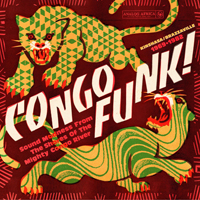




















 Spread from Actualités Africaines, March 1960, courtesy Alan Brain
Spread from Actualités Africaines, March 1960, courtesy Alan Brain